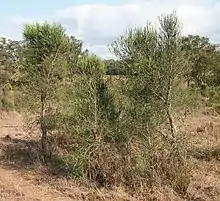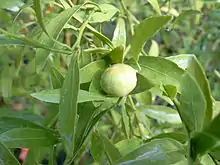Citrus glauca
Citrus glauca, commonly known as the desert lime, is a thorny shrub or small tree native to Queensland, New South Wales, and South Australia.[2][3]
| Citrus glauca | |
|---|---|
 | |
| Scientific classification | |
| Kingdom: | Plantae |
| Clade: | Tracheophytes |
| Clade: | Angiosperms |
| Clade: | Eudicots |
| Clade: | Rosids |
| Order: | Sapindales |
| Family: | Rutaceae |
| Genus: | Citrus |
| Species: | C. glauca |
| Binomial name | |
| Citrus glauca | |
| Synonyms[1] | |
Taxonomy
Under the Swingle system, the desert lime was classified in the genus Eremocitrus, a close relative of the genus Citrus. More recent taxonomy considers all the Australian limes to be included in the genus Citrus, and most authorities treat the desert lime this way. Citrus glauca is one of the most resilient Citrus species, and is comparatively heat, drought, and cold tolerant. Hence the species is potentially important for Citrus breeding programs, and readily hybridises with many common Citrus species.

Description
A shrub or small tree to 12 metres (39 ft), it has several unusual characteristics. It is cold, heat, drought and salinity tolerant and thought evergreen. If the rains should fail it will shed its leaves and live off the green bark on the plant branches. It will set fruit almost immediately after flowering and is the earliest citrus to do so. Fruit is small and variable and depends on current climatic conditions and genetic make-up. Thorns appear on low-growing branches to prevent grazing by rabbits, kangaroos, cattle etc but cease on branches above the grazing level. The limes are small with an intense piquant flavour, and good rainfall years produce an abundance of fruit.
Economic uses

The desert lime fruit is a highly prized bushfood. Traditionally, it is wild-harvested from surviving bushland areas, where it is relatively common. However, C. glauca has also been extensively cleared from some areas due to the ongoing conversion of the wild bush into agricultural fields.[4][5] The fruit are used in a range of products, including marmalades, beverages, and succade. It has a strong lime-like flavour.[6]
The fruit is beginning to be domesticated. Commercial cultivation of this fruit is beginning to reduce the reliance on wild-harvested product.[4][5]
Taxonomy, cultivars, and hybrids
| Australian limes |
| |||||||||||||||||||||||||||||||||
Australian outback lime
The Australian Outback lime was selected by CSIRO scientists from the regular desert lime. It is characterised by its upright habit, relatively large, flavoursome fruit, high yield, uniform ripening time, lack of thorns, and suitability for mechanical harvesting. The Australian Outback lime was cultivated at the former CSIRO Plant Industry site at Merbein, Victoria by Steve Sykes.[8]
Hybrids

The eremolemon is thought to be a Citrus glauca × Citrus meyeri hybrid. It grows quickly and tolerates saline soil.[9] Citrus plants hybridise readily. The eremolemon is thought to be a natural true-breeding cross between the desert lime and the Meyer lemon.[9] Other hybrids include eremoranges, eremoradias (hybrid with a sour orange) and citrangeremos (hybrid with a citrange).[10]
Notes
- "Citrus glauca (Lindl.) Burkill — The Plant List". Retrieved 14 May 2015.
- Burkill, Isaac Henry. 1932. Gardens' Bulletin, Straits Settlements 5 (Index): 3. Citrus glauca.
- Citrus pages, Native Australian Citrus, Citrus glauca Archived 2014-03-23 at the Wayback Machine
- Cherikoff, Vic, The Bushfood Handbook, ISBN 0-646-15496-6.
- Low, Tim, Wild Food Plants of Australia, ISBN 0-207-14383-8.
- Cherikoff, Vic, Uniquely Australian, ISBN 0-646-07470-9.
- Jorma Koskinen and Sylvain Jousse. "Citrus Pages / Native Australian varieties". free.fr. Archived from the original on 2015-07-11.
- "The Australian Outback Lime". CSIRO Science Image. Archived from the original on 6 January 2018. Retrieved 17 December 2020.
- Jorma Koskinen and Sylvain Jousse. "Native varieties from Australia and New Guinea / Eremolemon". Citrus Pages. Archived from the original on 11 July 2015. Retrieved 17 December 2020.
- Jorma Koskinen and Sylvain Jousse. "Native varieties from Australia and New Guinea / The citrus types previously known as Eremocitrus". Citrus Pages. Archived from the original on 11 July 2015. Retrieved 17 December 2020.
References
External links
- "Citrus glauca (Lindl.) Burkill". Atlas of Living Australia.
 Media related to Citrus glauca at Wikimedia Commons
Media related to Citrus glauca at Wikimedia Commons